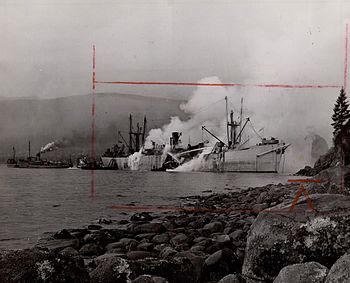SS Green Hill Park
The Greenhill Park was a freighter, built in 1943, that exploded, and burst into flames, in Vancouver, British Columbia's harbour, on March 6, 1945.[1] According to a 2013 retrospective article, in the Vancouver Sun, this was Vancouver's worst disaster, at the time it occurred.
The ship was owned by the Park Steamship Company, which was owned by Canada's Federal government.[2] The government had built 400 vessels during World War II. She was named after an actual park in Nova Scotia.
She was operated for the Government by Canada Shipping Company.[2]
The ship's destruction
The ship's cargo included 85 or 95 tons of Sodium Chlorate, commonly used as a fertilizer, but one of the fertilizers that, under certain conditions, can be a powerful high explosive.[1] Observers saw three explosions, and, initially, it was believed that portions of the ship's cargo of Sodium Chlorate exploded. Her cargo also included six tons of flares, and barrels of overproof whiskey.[2]
The ship was being loaded at a Canadian Pacific Railway pier, and six longshoremen, and two seamen, lost their lives.[1] Windows were broken all over Vancouver's downtown. Vancouver firefighters could not extinguish the blaze, so they beached her, near Siwash Rock, in Stanley Park, to prevent her drifting into other vessels, and setting them on fire.[3]
The Vancouver Sun reported that, eventually, some longshoremen confessed that they had clandestinely tapped the whisky barrels, and it ws the spilled whisky that was accidentally ignited, and started the fire.[1] John Stanton, reporting in the Northern Mariner, wrote that the whisky was 60 percent alcohol -- fifty percent more alcohol than normal whisky.[2] He wrote that those unfamiliar with it, may not have understood that the fumes from overproof alcohol are far more volatile, and explosive, than regular whisky.
Reconstruction and renaming
The Greenhill Park was severely damaged, but she was repaired, as sold off, and operated again under Panamaian ownership as the Phaeax II.[4][5][6] She was recommissioned at the Phaeax II in 1946, and as the Lagos Michigan in 1956.[7] She was scrapped in Taiwan, in 1967.
References
- ↑ 1.0 1.1 1.2 1.3 John Mackie. Photos: The 1945 SS Greenhill Park explosion, Vancouver Sun, 2013-03-05. Retrieved on 2017-03-29. “There were about 100 men working on the ship at the time of the explosion, and eight of them were killed. It was the worst disaster in Vancouver history to that point in time.”
- ↑ 2.0 2.1 2.2 2.3 John Stanton. THE GREEN HILL PARK DISASTER. Retrieved on 2017-03-29.
- ↑ Beached on historic Siwash Rock where she was towed after six explosions ripped her hull and shook downtown Vancouver yesterday noon; the freighter Greenhill Park stil burns furiously. A fireboat pours a steady stream of water into the hull., Toronto Public Library. Retrieved on 2017-03-29.
- ↑ Reginald Eyre Watters (1958). British Columbia: a centennial anthology. McClelland and Stewart. Retrieved on 2017-03-29. “Almost exactly a year after the disaster she is ready to sail under the name of Phaeax II. The cost to her new owners was only half of her original price of two million dollars in 1944, and she has been back in Vancouver several times since.”
- ↑ (1946) Canadian Shipping and Marine Engineering News, Volume 18. Maclean Publishing. Retrieved on 2017-03-29. “Then there was the famous Greenhill Park, now sailing the seas again as Phaeax II under the flag of Greece.”
- ↑ Syd C. Heal (1999). A Great Fleet of Ships: The Canadian Forts & Parks. Vanwell Publishing. ISBN 9781551250236.
